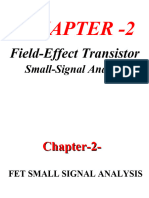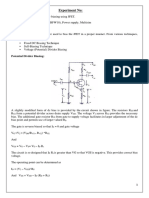Publication
Publication
Uploaded by
Andrei John EnriquezCopyright:
Available Formats
Publication
Publication
Uploaded by
Andrei John EnriquezOriginal Description:
Original Title
Copyright
Available Formats
Share this document
Did you find this document useful?
Is this content inappropriate?
Copyright:
Available Formats
Publication
Publication
Uploaded by
Andrei John EnriquezCopyright:
Available Formats
Electronic Devices
Chapter 7: FET Amplifiers Switching and Circuits
The Common-Source Amplifier
In a common-source (CS) amplifier, the input signal is applied to the gate and the output
signal is taken from the drain. The amplifier has higher input resistance and lower gain
than the equivalent CE amplifier.
Figure 1: JFET common-source amplifier.
The ac voltage gain of this circuit is Vout=Vin, where Vin=Vgs and Vout=Vds. The voltage
gain expression is, therefore,
Vds
Av =
Vgs
From the equivalent circuit, Vds=IdRd
and from the definition of transconductance, gm=Id/Vgs,
Substituting the two preceding expressions into the equation for voltage gain yields
Av=gm Rd
You can estimate what the transfer characteristic looks like from values on the
specification sheet, but keep in mind that large variations are common with JFETs.
Figure 2
54 Assist. Prof. Dr. Hamad Rahman
Electronic Devices
To analyze the CS amplifier, you need to start with dc values. It is useful to estimate ID
based on typical values; specific circuits will vary from this estimate. The gain is
reduced when a load is connected to the amplifier because the total ac drain resistance
(Rd) is reduced
Example: Determine the drain current for a typical 2N5458 JFET amplifier which
shown in the following Figure.
VDD
+12 V
RD
2.7 kW
C1 Vout
0.1 mF
Vin
100 mV RG RS C2
10 MW 470 W 10 mF
Solution: From the specification sheet, the typical IDSS = 6.0 mA and VGS(off) = -4 V.
These values can be plotted along with the load line to obtain a graphical solution.
A graphical solution is illustrated. On the transconductance curve, plot the load line
for the source resistor. Then read the current and voltage at the Q-point.
ID = 2.8 mA and VGS = -1.3 V
Alternatively, you can obtain ID using Equation
2
ID R S
ID = IDSS (1 − )
VGS(off)
Example: Assume IDSS is 6.0 mA, VGS(off) is -4 V, and VGS = -1.3 V as found previously.
What is the expected gain?
Solution:
Av = gmRD = (2.02 mS)(2.7 kΩ) = 5.45
55 Assist. Prof. Dr. Hamad Rahman
Electronic Devices
Example: How does the addition of the 10kΩ load affect the gain?
Solution: VDD
+12 V
RD
2.7 kW
Vout
C1
0.1 mF
Vin
100 mV RG RS C2 RL
10 MW 470 W 10 mF 10 kW
Av = gmRd = (2.02 mS)(2.13 kΩ) = 4.29
D-MOSFET Amplifier Operation
In operation, the D-MOSFET has the unique property in that it can be operated with zero
bias, allowing the signal to swing above and below ground. This means that it can
operate in either D-mode or E-mode.
+VDD
RD C2
Vout
C1
RL
Vin RG
Figure 3: (a) Zero-biased D-MOSFET (b) Depletion-enhancement operation D-MOSFET
common-source amplifier. shown on transfer characteristic curve.
E-MOSFET Amplifier Operation
The E-MOSFET is a normally off device. The n-channel device is biased on by making
the gate positive with respect to the source. A voltage-divider biased E-MOSFET
amplifier is shown in Figure 4.
Figure 4: (a) Common-source E-MOSFET (b) E-MOSFET (n-channel) operation
amplifier with voltage-divider bias. shown on transfer characteristic curve.
56 Assist. Prof. Dr. Hamad Rahman
Electronic Devices
The Common-Drain (CD) Amplifier
In a CD amplifier, the input signal is applied to the gate and the output signal is taken
from the source. There is no drain resistor, because it is common to the input and output
signals.
Figure 5: JFET common-drain amplifier (source-follower).
The voltage gain is given by the equation
gmRS
Av =
1 + gmRS
The voltage gain is always slightly < 1. If gmRs>>1, then a good approximation is 𝐴𝑣 ≅
1.
Common-Gate Amplifier Operation
A self-biased common-gate amplifier is shown in Figure 6. The gate is connected
directly to ground. The input signal is applied at the source terminal through C1. The
output is coupled through C2 from the drain terminal.
Figure 6: JFET common-gate amplifier.
The Class-D Amplifier
MOSFETs are useful as class-D amplifiers, which are very efficient because they
operate as switching amplifiers. They use pulse- width modulation (PWM), a process in
which the input signal is converted to a series of pulses. The pulse width varies
proportionally to the amplitude of the input signal.
57 Assist. Prof. Dr. Hamad Rahman
Electronic Devices
The modulated signal is amplified by class-B complementary MOSFET transistors. The
output is filtered by a low-pass filter to recover the original signal and remove the higher
modulation frequency. PWM is also useful in control applications such as motor
controllers. MOSFETs are widely used in these applications because of fast switching
time and low on-state resistance.
+VDD
Q1
Modulated
input Low-pass
filter
RL
Q2
–VDD
Figure 7: Complementary MOSFETs operating as switches to amplify power.
MOSFET Switching Operation
MOSFETs are also used as analog switches to connect or disconnect an analog signal.
Analog switches are available in IC form. The configuration shown allows signals to be
passed in either direction. Advantages of MOSFETs are that they have relatively low on-
state resistance and they can be used at high frequencies, such as found in video
applications. A basic n-channel MOSFET analog switch is shown in Figure 8. The
signal at the drain is connected to the source when the MOSFET is turned on by a
positive VGS and is disconnected when VGS is 0, as indicated.
Figure 9: Operation of an n-channel MOSFET analog switch.
Basic class D audio amplifier
58 Assist. Prof. Dr. Hamad Rahman
You might also like
- NormalDistribution ActivityAnswerKeyDocument18 pagesNormalDistribution ActivityAnswerKeyRafael Assunção86% (7)
- Frequency Response of A Single Stage RC Coupled AmplifierDocument26 pagesFrequency Response of A Single Stage RC Coupled Amplifierkanchankonwar100% (1)
- Lecture12-Small Signal Model-BJT PDFDocument12 pagesLecture12-Small Signal Model-BJT PDFKahina ZitouniNo ratings yet
- Chapter 2Document24 pagesChapter 2ahmdnmr213No ratings yet
- ENEE307 Lab6 FinalDocument11 pagesENEE307 Lab6 FinalThing0256No ratings yet
- Unit Vii Fet AmplifiersDocument14 pagesUnit Vii Fet AmplifiersAadarsha timilsina100% (1)
- DR Ahmed Heikal Lecture 5 PDFDocument33 pagesDR Ahmed Heikal Lecture 5 PDFArman KhanNo ratings yet
- Operational Amplifiers Theory and Practice Roberge Trang 361 405Document45 pagesOperational Amplifiers Theory and Practice Roberge Trang 361 405Tuyên NguyễnNo ratings yet
- Mosfet Part 3Document24 pagesMosfet Part 3MUHAMMAD KHAIRUL ANUAR BIN JUHARI A22EE0178No ratings yet
- JFETs and MOSFETSDocument17 pagesJFETs and MOSFETSBokang MaphatheNo ratings yet
- FET AmplifiersDocument67 pagesFET Amplifierssevenscarlet134No ratings yet
- BJTs Small SignalsDocument17 pagesBJTs Small SignalsBokang MaphatheNo ratings yet
- CH 9Document33 pagesCH 9mugammad wasimNo ratings yet
- Aec ReportDocument10 pagesAec ReportftrxarpitNo ratings yet
- Ece2201 SJB Lab5 ADocument4 pagesEce2201 SJB Lab5 AbikashNo ratings yet
- Unit VDocument23 pagesUnit Vammireddybhavya2006No ratings yet
- Lecture 12Document36 pagesLecture 122019n00984No ratings yet
- Lab6 PDFDocument10 pagesLab6 PDFganga_ch1No ratings yet
- App. Electronics Exp#6Document7 pagesApp. Electronics Exp#6muazam aliNo ratings yet
- Ee618 PDFDocument39 pagesEe618 PDFfilmfilmfNo ratings yet
- 13-MOSFET AmplifierDocument3 pages13-MOSFET AmplifierMert AçikelNo ratings yet
- Department of Electronics & Telecom Engineering EDC-1 Question Bank For IA-02 A.Y 2021-22Document7 pagesDepartment of Electronics & Telecom Engineering EDC-1 Question Bank For IA-02 A.Y 2021-22Pratik BhalakeNo ratings yet
- Electronic Circuits - 1 Unit - 3 Small Signal Analysis of JFET and MOSFET Amplifiers Biasing of Fet Amplifiers Fixed BiasDocument17 pagesElectronic Circuits - 1 Unit - 3 Small Signal Analysis of JFET and MOSFET Amplifiers Biasing of Fet Amplifiers Fixed BiasMutharasu SNo ratings yet
- Analog Integrated Circuits & Technology (EC 305) : Differential Amplifier With Passive Load and Its Detail AnalysisDocument13 pagesAnalog Integrated Circuits & Technology (EC 305) : Differential Amplifier With Passive Load and Its Detail AnalysisAbir HoqueNo ratings yet
- Buck Based LED DriverDocument22 pagesBuck Based LED DriverCruz JimenezNo ratings yet
- 19ec401 - Ec1 - 2021 - 2022 Lab Manual PDFDocument53 pages19ec401 - Ec1 - 2021 - 2022 Lab Manual PDFKarthi&coNo ratings yet
- Electronic Devices: FloydDocument33 pagesElectronic Devices: FloydArman KhanNo ratings yet
- CAP.4. Conv. DC-DC Cu IzolareDocument9 pagesCAP.4. Conv. DC-DC Cu IzolareCondracheClaudiaNo ratings yet
- ECE20L - 2 - Expt7 - DE LEMOS PDFDocument10 pagesECE20L - 2 - Expt7 - DE LEMOS PDFNiko de LemosNo ratings yet
- Chapter 4 - JFET PDFDocument13 pagesChapter 4 - JFET PDFnelsonjnelsonjNo ratings yet
- CH 9Document33 pagesCH 9Ramsha TariqNo ratings yet
- CHAP 4 MOSFET AC ANALYSIS (Part 3)Document42 pagesCHAP 4 MOSFET AC ANALYSIS (Part 3)2024963129No ratings yet
- Out 1 T 2Document16 pagesOut 1 T 2junaidlallmamodeNo ratings yet
- Small Signal Model MOSFETDocument8 pagesSmall Signal Model MOSFETRAHUL100% (1)
- Chapter8. FET Amplifier: FET Small-Signal Model Transconductance G Output Impedance RDocument22 pagesChapter8. FET Amplifier: FET Small-Signal Model Transconductance G Output Impedance RRaheemNo ratings yet
- Assignment 10 PDFDocument3 pagesAssignment 10 PDFjamesNo ratings yet
- FET (Field Effect Transistor) : Few Important Advantages of FET Over Conventional TransistorsDocument63 pagesFET (Field Effect Transistor) : Few Important Advantages of FET Over Conventional TransistorsgodfreyNo ratings yet
- PresentationDocument44 pagesPresentationRohit chachdaNo ratings yet
- Electronis 2 PDFDocument14 pagesElectronis 2 PDFMarco ReusNo ratings yet
- Chap3a - FET (v1.2)Document70 pagesChap3a - FET (v1.2)Al AidenNo ratings yet
- Experiment No: Aim: Apparatus: Theory:: Potential Divider BiasingDocument3 pagesExperiment No: Aim: Apparatus: Theory:: Potential Divider Biasingdipa0% (1)
- Experiment No 2 (Fet)Document4 pagesExperiment No 2 (Fet)Jaideep Singh100% (1)
- Bias Circuit Design For Microwave AmplifiersDocument7 pagesBias Circuit Design For Microwave AmplifiersPhilippeaNo ratings yet
- QB MSDDocument10 pagesQB MSDv Suvas vidyashankarNo ratings yet
- Infineon-Application Note Applications For Depletion MOSFETs-An-V01 00-EnDocument13 pagesInfineon-Application Note Applications For Depletion MOSFETs-An-V01 00-EnP.r. Nuwan TharakaNo ratings yet
- 13 MOSFET AmplifierDocument1 page13 MOSFET AmplifierAbhishek PandeyNo ratings yet
- Simplified Cascade Multiphase DC-DC Boost Power Converters For High Voltage-Gain and Low-Ripple ApplicationsDocument13 pagesSimplified Cascade Multiphase DC-DC Boost Power Converters For High Voltage-Gain and Low-Ripple ApplicationsInternational Journal of Power Electronics and Drive SystemsNo ratings yet
- Lecture 8 - Multistage AmplifiersDocument43 pagesLecture 8 - Multistage AmplifiersRanjan KarkiNo ratings yet
- Chap-4 Field Effect TransistorDocument18 pagesChap-4 Field Effect Transistorbiruk satnawNo ratings yet
- Tutorial On FetsDocument9 pagesTutorial On Fetsaishuvc1822No ratings yet
- An 4102 PDFDocument16 pagesAn 4102 PDFOmprakash DagarNo ratings yet
- Application Note AN-4150: Design Guidelines For Flyback Converters Using FSQ-series Fairchild Power Switch (FPS™)Document16 pagesApplication Note AN-4150: Design Guidelines For Flyback Converters Using FSQ-series Fairchild Power Switch (FPS™)Nagendra ChaitanyaNo ratings yet
- EEE 111 Lab Manual 2Document6 pagesEEE 111 Lab Manual 2SHADOW manNo ratings yet
- Synchronous Rectifiers Enable High Efficiency For Buck-Boost ConverterDocument4 pagesSynchronous Rectifiers Enable High Efficiency For Buck-Boost ConverterSmakshi ChoudharyNo ratings yet
- Tutorial 7Document9 pagesTutorial 7tutulkarNo ratings yet
- 1 To 5 ManualDocument30 pages1 To 5 ManualRoshan DodiyaNo ratings yet
- 5.) Common Drain AmplifierDocument5 pages5.) Common Drain AmplifierJuay Mae Riano100% (1)
- Ed 8 To 11Document33 pagesEd 8 To 11Outfit BSNo ratings yet
- Reference Guide To Useful Electronic Circuits And Circuit Design Techniques - Part 1From EverandReference Guide To Useful Electronic Circuits And Circuit Design Techniques - Part 1Rating: 2.5 out of 5 stars2.5/5 (3)
- Defeo Q4 ME150-2Document12 pagesDefeo Q4 ME150-2Andrei John EnriquezNo ratings yet
- Rotor Exp1Document4 pagesRotor Exp1Andrei John EnriquezNo ratings yet
- Front PageDocument1 pageFront PageAndrei John EnriquezNo ratings yet
- Lab 1Document2 pagesLab 1Andrei John EnriquezNo ratings yet
- M1 CO1 (1) Construction of DC MachineDocument17 pagesM1 CO1 (1) Construction of DC MachineAndrei John EnriquezNo ratings yet
- Math142 CheatsheetDocument4 pagesMath142 CheatsheetAndrei John EnriquezNo ratings yet
- M2 CO2 (4) DC Motor CharacteristicsDocument8 pagesM2 CO2 (4) DC Motor CharacteristicsAndrei John EnriquezNo ratings yet
- Module 2 - Summative Test in Writing - A Product ReviewDocument4 pagesModule 2 - Summative Test in Writing - A Product ReviewAndrei John EnriquezNo ratings yet
- Group Rating Form GROUP6Document2 pagesGroup Rating Form GROUP6Andrei John EnriquezNo ratings yet
- Hindustan UnilieverDocument8 pagesHindustan UnilieverTeodoraŞaperaNo ratings yet
- Foreign Exchange Management Act, 2000: Presented By: Akanksha MalhotraDocument19 pagesForeign Exchange Management Act, 2000: Presented By: Akanksha MalhotraGaurav KumarNo ratings yet
- Sample Questions C THR12 66Document5 pagesSample Questions C THR12 66aijlalNo ratings yet
- Oracle Cloud Applications: Standard Infrastructure Installation GuideDocument44 pagesOracle Cloud Applications: Standard Infrastructure Installation GuideNestor R TorresNo ratings yet
- Grade 7 Science Practice Test 2019-20Document70 pagesGrade 7 Science Practice Test 2019-20ggNo ratings yet
- Learning Objectives:: Communication and TechnologyDocument6 pagesLearning Objectives:: Communication and TechnologyKeen Jude CaminosNo ratings yet
- CLASSMARKER - Guidelines For Teachers (12.10.2021)Document9 pagesCLASSMARKER - Guidelines For Teachers (12.10.2021)Trần thị mỹ duyênNo ratings yet
- Night Shift FormDocument2 pagesNight Shift FormAnonymous kWfNFbNo ratings yet
- CMH - Pub - 10-4 Corps of Engineers - TroopsDocument641 pagesCMH - Pub - 10-4 Corps of Engineers - TroopsGavin Hardie100% (1)
- Sesi 3 Economic Terms From D To EDocument4 pagesSesi 3 Economic Terms From D To EARSYFA MEISYANo ratings yet
- PATHOPHYSIOLOGY ECTOPIC PREGNANCY SoftDocument11 pagesPATHOPHYSIOLOGY ECTOPIC PREGNANCY SoftJann ericka JaoNo ratings yet
- Consumption FrenzyDocument2 pagesConsumption Frenzyİsa YaşarNo ratings yet
- Payment of Claims - AuditChecklist - Template - DA12Document15 pagesPayment of Claims - AuditChecklist - Template - DA12Elly Paul Andres TomasNo ratings yet
- EMR1739DDocument4 pagesEMR1739Dbeppe530% (1)
- Wood ColorDocument2 pagesWood Color4uengineerNo ratings yet
- D. S. Chandrasekharaiah and Lokenath Debnath (Auth.) - Continuum Mechanics-Elsevier Inc, Academic Press (1994)Document599 pagesD. S. Chandrasekharaiah and Lokenath Debnath (Auth.) - Continuum Mechanics-Elsevier Inc, Academic Press (1994)amit yadav93% (14)
- Compitition of Yacon RootDocument8 pagesCompitition of Yacon RootArfi MaulanaNo ratings yet
- Bharti Airtel Limite1 Sales & DistributionDocument22 pagesBharti Airtel Limite1 Sales & DistributionAshwini JhaNo ratings yet
- Gas Insulated TransformerDocument12 pagesGas Insulated Transformermithun1105No ratings yet
- Hacer MapasDocument29 pagesHacer MapaspafrikiyoNo ratings yet
- Yustika Adiningsih-F0319141-Mindmap SPM A Chapter 6 Dan 7Document2 pagesYustika Adiningsih-F0319141-Mindmap SPM A Chapter 6 Dan 7yes iNo ratings yet
- Schlage S-6800 ManualDocument32 pagesSchlage S-6800 Manualgeotechsoil1100% (1)
- EAPPDocument3 pagesEAPPMa LouNo ratings yet
- Business Structure: Partnership: DefinitionDocument6 pagesBusiness Structure: Partnership: DefinitionStephen VillanteNo ratings yet
- ABS Case Study PDFDocument5 pagesABS Case Study PDFMiano MuturiNo ratings yet
- NOJA-519-07 DNP3 Protocol Implementation PDFDocument40 pagesNOJA-519-07 DNP3 Protocol Implementation PDFDale Johnson100% (2)
- GRAMMER Repair Manual MSG95A L VaremoDocument237 pagesGRAMMER Repair Manual MSG95A L Varemomnowaq100% (1)
- AC Substation Detailed Design Guidelines Best Practice Dos and DontsDocument29 pagesAC Substation Detailed Design Guidelines Best Practice Dos and Dontsahmad shakeebNo ratings yet
- Analyzing Market Share of Thermax Boiler and Fuel Usage PatternDocument25 pagesAnalyzing Market Share of Thermax Boiler and Fuel Usage PatternvikramporjeNo ratings yet


































































































